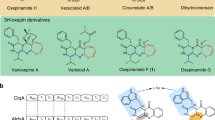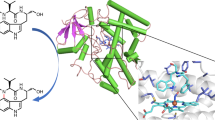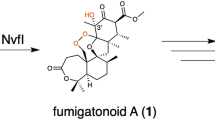Abstract
Thaxtomin phytotoxins produced by plant-pathogenic Streptomyces species contain a nitro group that is essential for phytotoxicity. The N,N′-dimethyldiketopiperazine core of thaxtomins is assembled from L-phenylalanine and L-4-nitrotryptophan by a nonribosomal peptide synthetase, and nitric oxide synthase–generated NO is incorporated into the nitro group, but the biosynthesis of the nonproteinogenic amino acid L-4-nitrotryptophan is unclear. Here we report that TxtE, a unique cytochrome P450, catalyzes L-tryptophan nitration using NO and O2.
This is a preview of subscription content, access via your institution
Access options
Subscribe to this journal
Receive 12 print issues and online access
$259.00 per year
only $21.58 per issue
Buy this article
- Purchase on Springer Link
- Instant access to full article PDF
Prices may be subject to local taxes which are calculated during checkout


Similar content being viewed by others
References
Scheible, W.R. et al. Plant Cell 15, 1781–1794 (2003).
Kers, J.A. et al. Mol. Microbiol. 55, 1025–1033 (2005).
Kers, J.A. et al. Nature 429, 79–82 (2004).
Wach, M.J., Kers, J.A., Krasnoff, S.B., Loria, R. & Gibson, D.M. Nitric Oxide 12, 46–53 (2005).
Johnson, E.G. et al. Mol. Microbiol. 73, 409–418 (2009).
Winkler, R. & Hertweck, C. ChemBioChem 8, 973–977 (2007).
Roncone, R., Barbieri, M., Monzani, E. & Casella, L. Coord. Chem. Rev. 250, 1286–1293 (2006).
Buddha, M.R. et al. J. Biol. Chem. 279, 49567–49570 (2004).
Sono, M., Roach, M.P., Coulter, E.D. & Dawson, J.H. Chem. Rev. 96, 2841–2888 (1996).
Denisov, I.G., Makris, T.M., Sligar, S.G. & Schlichting, I. Chem. Rev. 105, 2253–2277 (2005).
Quaroni, L.G. et al. Biochemistry 43, 16416–16431 (2004).
Franke, A. et al. J. Am. Chem. Soc. 126, 4181–4191 (2004).
Nakahara, K. et al. J. Biol. Chem. 268, 8350–8355 (1993).
Bourn, W.R. & Babb, B. Nucleic Acids Res. 23, 3696–3703 (1995).
Omura, T. & Sato, R. J. Biol. Chem. 239, 2379–2385 (1964).
Schenkman, J.B., Remmer, H. & Estabrook, R.W. Mol. Pharmacol. 3, 113–123 (1967).
Ishii, Y. et al. J. Pharm. Biomed. Anal. 44, 150–159 (2007).
Ottoni, O., Cruz, R. & Krammer, N.H. Tetrahedr. Lett. 40, 1117–1120 (1999).
Osborne, A.S., Som, P., Metcalf, J.L. & Phillips, R.S. Bioorg. Med. Chem. Lett. 18, 5750–5752 (2008).
Acknowledgements
We thank P. Patel for assistance with fitting the L-tryptophan binding data to the one-site binding model. We also thank The UK Biotechnology and Biological Sciences Research Council (grant ref. BB/H006281/1 to G.L.C.) and the National Research Initiative of the United States Department of Agriculture Cooperative State Research, Education and Extension Service (grant no. 2008-35319-19202 to R.L.) for funding this research. The Bruker maXis mass spectrometer used in this research was obtained through Birmingham Science City: Innovative Uses for Advanced Materials in the Modern World with support from Advantage West Midlands and was partially funded by the European Regional Development Fund.
Author information
Authors and Affiliations
Contributions
S.M.B., G.L.C., J.A.K., E.G.J. and R.L. designed the research. S.M.B., J.A.K., E.G.J., L.S., P.R.A. and B.P. performed the research. S.M.B., G.L.C., L.S., R.L., J.A.K., E.G.J., S.B.K., D.M.G. and B.R.C. analyzed data. S.M.B., G.L.C., J.A.K., E.G.J., R.L. and B.R.C. wrote the paper.
Corresponding authors
Ethics declarations
Competing interests
The authors declare no competing financial interests.
Supplementary information
Supplementary Text and Figures
Supplementary Methods and Supplementary Results (PDF 2012 kb)
Rights and permissions
About this article
Cite this article
Barry, S., Kers, J., Johnson, E. et al. Cytochrome P450–catalyzed L-tryptophan nitration in thaxtomin phytotoxin biosynthesis. Nat Chem Biol 8, 814–816 (2012). https://doi.org/10.1038/nchembio.1048
Received:
Accepted:
Published:
Issue Date:
DOI: https://doi.org/10.1038/nchembio.1048
This article is cited by
-
Hydroxytryptophan biosynthesis by a family of heme-dependent enzymes in bacteria
Nature Chemical Biology (2023)
-
Pathogenic Factors of Plant Pathogenic Streptomyces
Potato Research (2023)
-
Regulation of P450 TleB catalytic flow for the synthesis of sulfur-containing indole alkaloids by substrate structure-directed strategy and protein engineering
Science China Chemistry (2023)
-
Deciphering host–pathogen interaction during Streptomyces spp. infestation of potato
Archives of Microbiology (2023)
-
Programmable late-stage C−H bond functionalization enabled by integration of enzymes with chemocatalysis
Nature Catalysis (2021)



